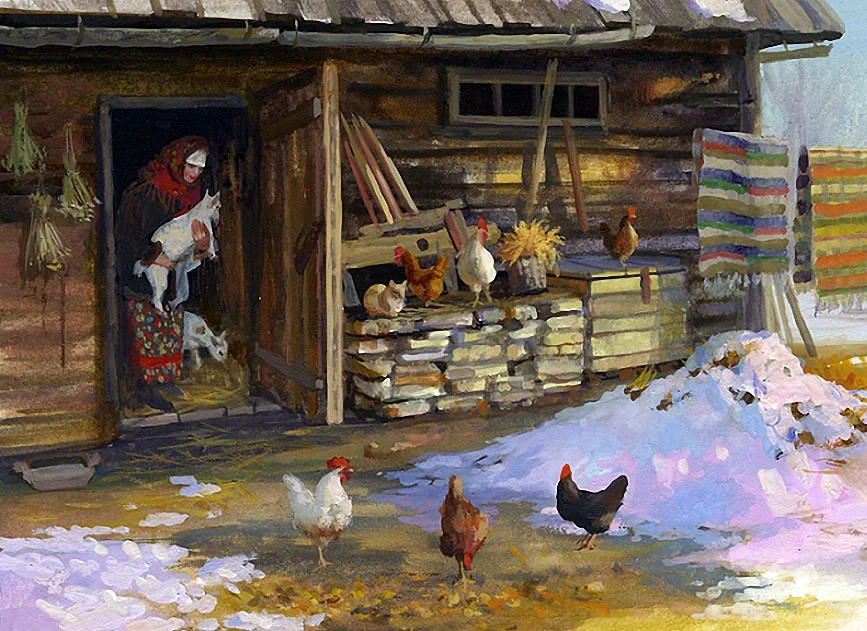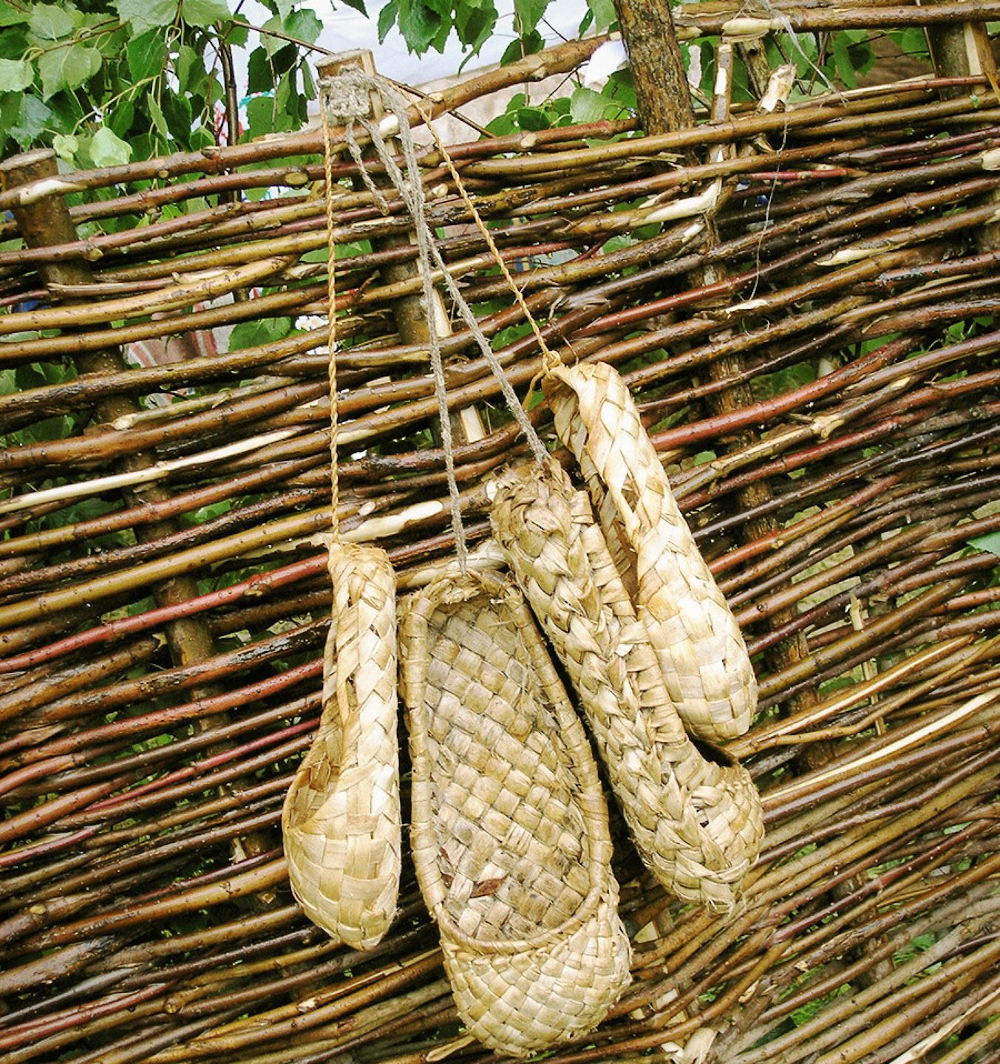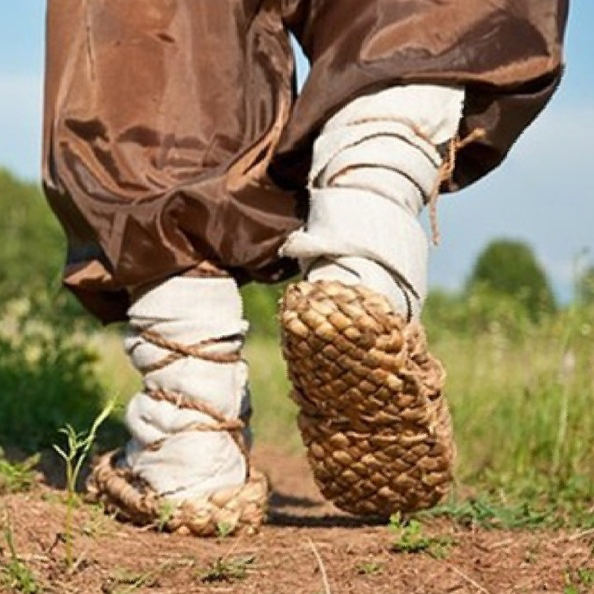To protect the yard from evil spirits, evil eye, curse, etc. Slavs took various magical measures. The Bulgarians, for example, planted elm tree. They believed that then “no evil and no disease can enter the yard, and the house itself will never be empty.”
ꏍ
Slavs of Polesie region made sure that no “bare” branch (without a bark), brought by the wind, was kept in the yard – to prevent it from being “naked” and “empty”. On Kupala they also erected a “pole with bark” in the yard, and put a cow skull on a top, so that the “yard (house) would be rich”.
ꏍ
According to the beliefs of some western and southern Slavs, in order to protect the yard from reptiles and insects, one should run around it with a bell in hand or sweep it before sunset with a new broom. Another way was to fumigate with a smoke and sprinkle with ashes from a fire, in which garbage from all over the yard was collected. To guard the yard from evil forces, salt was also sprinkled along the fence. To defend the barn from the witch who was trying to “steal” the crop, millet was scattered in the yard. And the Russians, in order to protect livestock from the evil eye, hung out a bunch of old bast shoes in the yard, thus diverting the attention of a dangerous person from animals.
ꏍ
What protection, in your opinion, is the most effective?
ꏍ
To be continued…
Artist: Vladimir Zhdanov
ꏍ
Lapti (bast shoes) and evil spirits
Lapti (bast shoes) and evil spirits.
ꏍ
Bast shoes are often mentioned in connection to mythological creatures. Leshy and Polevik (field spirit) are often portrayed wearing lapti. Weaving bast shoes is a favorite activity of evil characters, and Vodyanoi in particular.
ꏍ
Bast shoes were also used to appease evil spirits. Vologda fishermen and millers threw bast shoes into the water to get help from Vodyanoi. If the cattle were lost, the peasants of the Smolensk region appealed to Rusalki. They went to the forest and brought with them bast shoes, footcloth, bread & salt and left it in a sack on a tree with the words: “Please, Rusalki, accept my gift, and return the cattle!”. In the Kostroma region, when moving to a new house, the owners went to the old yard with one bast shoe and invited Domovoy to go with them in that shoe. In the Vladimir region, people supplied Domovoy with shoes, by hanging old worn “little lapti” in the yard.
ꏍ
The need for shoes for Domovoy is understandable. But what would Rusalki do with them? 😉
ꏍ
More interesting facts can be found in: “Slavic Antiquities” – encyclopedic dictionary in 5 volumes by Institute for Slavic Studies of the Russian Academy of Sciences.
ꏍ

Lapti as a talisman
Lapti (bast shoes) were used in magical practice as a talisman. The Russians hung out old bast shoes near the barnyard, in front of the house, or at the gate. This was done in order to protect the house and livestock from the evil eye: anyone who came will first look at the pile of bast shoes and “break his eyes” at them, therefore, will lose the opportunity to inflict damage. These rituals can also be viewed as a sacrifice of shoes to deceased ancestors, who, according to Slavic beliefs, periodically visit their native places and need shoes for their travels.
ꏍ
Leaky bast shoes could serve as the amulet called the “Chicken God” (see our previous posts). Old and leaky bast shoes also served as a talisman in family rituals. To prevent the baby from crying at night, a bast shoe was placed at the head of the crib with the words: “Let the child be silent as this bast shoe”.
ꏍ
Lapti were also used in fertility stimulating rituals. For example, when planting cabbage, old bast shoes were buried at the end of each row so that the cabbage heads were large and dense. And in the Vologda region, a calving cow was fumigated from the owner’s right bast shoe.
ꏍ
What do you think they did with the remaining bast shoe from the owner’s left foot? 😉
ꏍ
To be continued…
ꏍ
Slavic bast shoes – Lapti
Bast shoes (lapti) were known mainly among the Eastern Slavs. They have been used in a variety of ceremonies and rituals. Water from bast shoes was given to a woman in labor to facilitate childbirth. Before the wedding in the southern Russian regions, the groom personally wove holiday bast shoes for his chosen one. Bast shoes could be a wedding gift to the bride or a gift to a girl in matchmaking (if she accepted them, this was a sign of agreement).
ꏍ
Bast shoes woven in a special way were put on the dead. Slavs believed that these shoes protect from evil spirits and prevent deceased from turning into a vampire. Even when Slavs no longer wore bast shoes in everyday life, they still preferred to put them on the deceased, instead of boots – because boots had “a lot of iron”, which would make it hard for a deceased to walk in the “other world”.
ꏍ
Ukrainians and Belarusians destroyed old bast shoes in Kupala bonfires along with other old utensils. And in the Bryansk region, on Kupala night, people hung bast shoes on a high pole and burned the entire structure while singing Kupala songs.
ꏍ
Do you see bast shoes are being used in our time anywhere outside of the museums?
ꏍ
To be continued…
ꏍ

